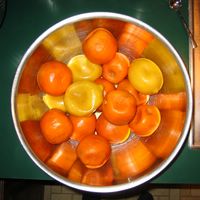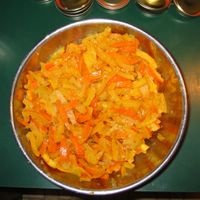Tuesday, February 15, 2005
Orange you glad?
I have heard for years that the only way to make real orange marmalade is with seville oranges, a type of bitter orange that is not common in this country. I didn't know that it was possible to get fresh seville oranges here, so I made do with making marmalades of sweet oranges, lemons and limes. And nice marmalades they were, every one, but they didn't have the edge of a - dare I say it - a proper English seville orange marmalade.
Late last week, I heard from a friend that her mother had found fresh seville oranges at our local Whole Foods market. On Saturday, I went on a highly successful mission of acquisition. On Sunday, I made seville orange marmalade. Here's how:
 Step One: Simmer four pounds of seville oranges and four lemons in water to cover for one and one half hours. That's whole oranges and lemons; remove only the small stem ends of the fruit. This is the strangest first step that I have seen in a preserves recipe, though by no means have I seen them all. I know that the intent is to cook the citrus rind, but I don't understand what the advantage is to cooking the fruit whole, especially as a) the recipe indicates that the simmering liquid is to be reserved and b) the fairly thin-skinned organic lemons split open during simmering, releasing much of their juice into the water. While the oranges do not split open, when removed from the pan at the end of simmering, their skins have become wrinkled and indented, as if they have become too large for the fruit inside. Step One makes the entire house smell lovely, as if it has just been cleaned with one of those orange oil based cleaners, minus any cleaner smell.
Step One: Simmer four pounds of seville oranges and four lemons in water to cover for one and one half hours. That's whole oranges and lemons; remove only the small stem ends of the fruit. This is the strangest first step that I have seen in a preserves recipe, though by no means have I seen them all. I know that the intent is to cook the citrus rind, but I don't understand what the advantage is to cooking the fruit whole, especially as a) the recipe indicates that the simmering liquid is to be reserved and b) the fairly thin-skinned organic lemons split open during simmering, releasing much of their juice into the water. While the oranges do not split open, when removed from the pan at the end of simmering, their skins have become wrinkled and indented, as if they have become too large for the fruit inside. Step One makes the entire house smell lovely, as if it has just been cleaned with one of those orange oil based cleaners, minus any cleaner smell.
 Step Two: Cut up all of the oranges and lemons into small pieces. This involves a) allowing the fruit to cool until one can handle it without screaming and scaring the cats, b) slicing each fruit in half and scooping/squeezing out its juice, seeds and pith, c) slicing the rinds and bits of fruit still attached into approximately 1/4" x 2" pieces, and d) pressing the guts of the fruit through a sieve to extract the juice. The seeds, pith and fruit that remain go into a cheesecloth bag, to be cooked with the marmalade. Step Two makes one's hands feel lovely and smooth, a combination, I believe, of the exfoliating properties of the citrus juice and moisturizing properties of the orange oil. Having one's hands smell like oranges is very nice, although the cats seem not to find it so.
Step Two: Cut up all of the oranges and lemons into small pieces. This involves a) allowing the fruit to cool until one can handle it without screaming and scaring the cats, b) slicing each fruit in half and scooping/squeezing out its juice, seeds and pith, c) slicing the rinds and bits of fruit still attached into approximately 1/4" x 2" pieces, and d) pressing the guts of the fruit through a sieve to extract the juice. The seeds, pith and fruit that remain go into a cheesecloth bag, to be cooked with the marmalade. Step Two makes one's hands feel lovely and smooth, a combination, I believe, of the exfoliating properties of the citrus juice and moisturizing properties of the orange oil. Having one's hands smell like oranges is very nice, although the cats seem not to find it so.
 Step Three: Add many, many cups of sugar, almost all of the sugar in the house (my house, that is; you may have more than 14 cups of sugar in your house), sugar half white and half brown, to the reserved simmering liquid. Bring the resulting syrup to a boil; on a late 1970's vintage electric stove, this will take a long time. So as not to watch the pot attempting to boil, perform some small tasks, such as unloading the dishwasher. Place a small plate in the freezer. When, despite one's impatience, the syrup is boiling, add all of the orange and lemon rind and the bag of seeds and pith, and boil for half an hour. Although the syrup is dark from the brown sugar, see the orange peel candying and turning translucent at the edges as the syrup thickens. Remove the small plate from the freezer, drip a few drops of syrup onto it. The syrup does not gel. Twice more at five-minute intervals, repeat this procedure; the third time may be the proverbial charm. Remove the now-marmalade from the stove, and remove the bag of seeds, squeezing to release as much seedy goodness as possible. Pour in 3/8 cup of orange liqueur, which will boil on the surface of the hot marmalade; stir it in.
Step Three: Add many, many cups of sugar, almost all of the sugar in the house (my house, that is; you may have more than 14 cups of sugar in your house), sugar half white and half brown, to the reserved simmering liquid. Bring the resulting syrup to a boil; on a late 1970's vintage electric stove, this will take a long time. So as not to watch the pot attempting to boil, perform some small tasks, such as unloading the dishwasher. Place a small plate in the freezer. When, despite one's impatience, the syrup is boiling, add all of the orange and lemon rind and the bag of seeds and pith, and boil for half an hour. Although the syrup is dark from the brown sugar, see the orange peel candying and turning translucent at the edges as the syrup thickens. Remove the small plate from the freezer, drip a few drops of syrup onto it. The syrup does not gel. Twice more at five-minute intervals, repeat this procedure; the third time may be the proverbial charm. Remove the now-marmalade from the stove, and remove the bag of seeds, squeezing to release as much seedy goodness as possible. Pour in 3/8 cup of orange liqueur, which will boil on the surface of the hot marmalade; stir it in.
Step Four: Fill eight half-pint jars (all that my small canner will hold) with marmalade, and set them in boiling water to process. Realize that the remaining four jars will not be sufficient unto the quantity of marmalade that has been produced, as, in a surreal twist, the recipe has made considerably more marmalade than advertised. Scrounge in the basement for an additional four jars and rims, and quickly sterilize them. By the time that the first eight jars come out of the canner, have another eight jars waiting to go in. The Step Three photo is what was left in the pot after I'd filled 16 half-pint jars. It is mostly softly chewy, sweet-sour-bitter slices of orange peel, with a binder of sweet orange jelly.
Step Five: (This morning). Warm brioche bun from Macrina Bakery; split in half. Spoon a few bites of marmalade onto bun. Eat. Do not attempt to control wordless sounds of pleasure that come unbidden from deep in chest. Enjoy. Look at all those jars of marmalade on kitchen counter. Look at remaining four pounds of seville oranges on kitchen table. Smile.
Late last week, I heard from a friend that her mother had found fresh seville oranges at our local Whole Foods market. On Saturday, I went on a highly successful mission of acquisition. On Sunday, I made seville orange marmalade. Here's how:
 Step One: Simmer four pounds of seville oranges and four lemons in water to cover for one and one half hours. That's whole oranges and lemons; remove only the small stem ends of the fruit. This is the strangest first step that I have seen in a preserves recipe, though by no means have I seen them all. I know that the intent is to cook the citrus rind, but I don't understand what the advantage is to cooking the fruit whole, especially as a) the recipe indicates that the simmering liquid is to be reserved and b) the fairly thin-skinned organic lemons split open during simmering, releasing much of their juice into the water. While the oranges do not split open, when removed from the pan at the end of simmering, their skins have become wrinkled and indented, as if they have become too large for the fruit inside. Step One makes the entire house smell lovely, as if it has just been cleaned with one of those orange oil based cleaners, minus any cleaner smell.
Step One: Simmer four pounds of seville oranges and four lemons in water to cover for one and one half hours. That's whole oranges and lemons; remove only the small stem ends of the fruit. This is the strangest first step that I have seen in a preserves recipe, though by no means have I seen them all. I know that the intent is to cook the citrus rind, but I don't understand what the advantage is to cooking the fruit whole, especially as a) the recipe indicates that the simmering liquid is to be reserved and b) the fairly thin-skinned organic lemons split open during simmering, releasing much of their juice into the water. While the oranges do not split open, when removed from the pan at the end of simmering, their skins have become wrinkled and indented, as if they have become too large for the fruit inside. Step One makes the entire house smell lovely, as if it has just been cleaned with one of those orange oil based cleaners, minus any cleaner smell. Step Two: Cut up all of the oranges and lemons into small pieces. This involves a) allowing the fruit to cool until one can handle it without screaming and scaring the cats, b) slicing each fruit in half and scooping/squeezing out its juice, seeds and pith, c) slicing the rinds and bits of fruit still attached into approximately 1/4" x 2" pieces, and d) pressing the guts of the fruit through a sieve to extract the juice. The seeds, pith and fruit that remain go into a cheesecloth bag, to be cooked with the marmalade. Step Two makes one's hands feel lovely and smooth, a combination, I believe, of the exfoliating properties of the citrus juice and moisturizing properties of the orange oil. Having one's hands smell like oranges is very nice, although the cats seem not to find it so.
Step Two: Cut up all of the oranges and lemons into small pieces. This involves a) allowing the fruit to cool until one can handle it without screaming and scaring the cats, b) slicing each fruit in half and scooping/squeezing out its juice, seeds and pith, c) slicing the rinds and bits of fruit still attached into approximately 1/4" x 2" pieces, and d) pressing the guts of the fruit through a sieve to extract the juice. The seeds, pith and fruit that remain go into a cheesecloth bag, to be cooked with the marmalade. Step Two makes one's hands feel lovely and smooth, a combination, I believe, of the exfoliating properties of the citrus juice and moisturizing properties of the orange oil. Having one's hands smell like oranges is very nice, although the cats seem not to find it so. Step Three: Add many, many cups of sugar, almost all of the sugar in the house (my house, that is; you may have more than 14 cups of sugar in your house), sugar half white and half brown, to the reserved simmering liquid. Bring the resulting syrup to a boil; on a late 1970's vintage electric stove, this will take a long time. So as not to watch the pot attempting to boil, perform some small tasks, such as unloading the dishwasher. Place a small plate in the freezer. When, despite one's impatience, the syrup is boiling, add all of the orange and lemon rind and the bag of seeds and pith, and boil for half an hour. Although the syrup is dark from the brown sugar, see the orange peel candying and turning translucent at the edges as the syrup thickens. Remove the small plate from the freezer, drip a few drops of syrup onto it. The syrup does not gel. Twice more at five-minute intervals, repeat this procedure; the third time may be the proverbial charm. Remove the now-marmalade from the stove, and remove the bag of seeds, squeezing to release as much seedy goodness as possible. Pour in 3/8 cup of orange liqueur, which will boil on the surface of the hot marmalade; stir it in.
Step Three: Add many, many cups of sugar, almost all of the sugar in the house (my house, that is; you may have more than 14 cups of sugar in your house), sugar half white and half brown, to the reserved simmering liquid. Bring the resulting syrup to a boil; on a late 1970's vintage electric stove, this will take a long time. So as not to watch the pot attempting to boil, perform some small tasks, such as unloading the dishwasher. Place a small plate in the freezer. When, despite one's impatience, the syrup is boiling, add all of the orange and lemon rind and the bag of seeds and pith, and boil for half an hour. Although the syrup is dark from the brown sugar, see the orange peel candying and turning translucent at the edges as the syrup thickens. Remove the small plate from the freezer, drip a few drops of syrup onto it. The syrup does not gel. Twice more at five-minute intervals, repeat this procedure; the third time may be the proverbial charm. Remove the now-marmalade from the stove, and remove the bag of seeds, squeezing to release as much seedy goodness as possible. Pour in 3/8 cup of orange liqueur, which will boil on the surface of the hot marmalade; stir it in.Step Four: Fill eight half-pint jars (all that my small canner will hold) with marmalade, and set them in boiling water to process. Realize that the remaining four jars will not be sufficient unto the quantity of marmalade that has been produced, as, in a surreal twist, the recipe has made considerably more marmalade than advertised. Scrounge in the basement for an additional four jars and rims, and quickly sterilize them. By the time that the first eight jars come out of the canner, have another eight jars waiting to go in. The Step Three photo is what was left in the pot after I'd filled 16 half-pint jars. It is mostly softly chewy, sweet-sour-bitter slices of orange peel, with a binder of sweet orange jelly.
Step Five: (This morning). Warm brioche bun from Macrina Bakery; split in half. Spoon a few bites of marmalade onto bun. Eat. Do not attempt to control wordless sounds of pleasure that come unbidden from deep in chest. Enjoy. Look at all those jars of marmalade on kitchen counter. Look at remaining four pounds of seville oranges on kitchen table. Smile.


 Music and Cats
Music and Cats